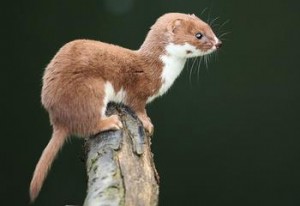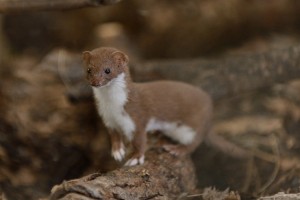Least Weasel
The least weasel is the smallest species of the weasel family and is also known as only the “weasel” in the United Kingdom. It is the smallest carnivore in the world with a typical long and slender body contour. This mammal has long whiskers, big eyes, relatively short limbs and a short tail.
Even though the least weasel is small in size, it has a huge appetite and can hunt animals that are larger than its size. Their coat changes color for the northern populations; it is rusty chocolate brown in summer and turns pure white in winter. However, the southern population does not change their coat color seasonally.
Least Weasel Scientific Classification
| Kingdom | Animalia |
| Phylum | Chordata |
| Class | Mammalia |
| Order | Carnivora |
| Family | Mustelidae |
| Genus | Mustela |
| Scientific Name | Mustela Nivalis |
Least Weasel Quick Information
| Other Popular Names | Common Weasel, European Weasel, Belette d’Europe (French), Comadreja (Spanish ) |
| Size | 165 to 217 mm |
| Weight | 30 to 100 gm |
| Color | Ginger to chocolate, russet brown with creamy white under-parts in summer, weasels in the northern ranges turn white in winter |
| Distribution | Circumboreal, Holarctic distribution that encompasses Europe, Asia, North Africa and Northern North America. |
| Habitat | Coniferous and deciduous forests, prairie grasslands, bushy taiga, open tundra and rainforests. |
| Sound | Low trills; loud and harsh chirps or screeches during hunting or fighting.
Babies – High pitched squeaks |
| Litter Size | 4 to 6 young ones called kits |
| Gestation Period | 34 to 37 days |
| Lifespan | Up to 3 years in the wild |
| Diet | Rats, small birds, rabbits, mice, moles, bird’s eggs and poultry |
| Predators | Large hawks and owls |
| IUCN Conservation Status | Least Concern |
Behavior
Least Weasels are generally solitary animals that live alone, with the exception of the breeding season when the otherwise sedentary males traverse distances in search of females. They have a territorial pattern that is typical of most mustelids with unique male home ranges that include many female home ranges. The male least weasel increases its home range in spring and when there are food shortages.
These mammals have hierarchies where the older males exercise their dominance over females and the juvenile males. The dominant males attacks other males and make them squeal and retreat. However, the females fight back when attacked even though they submit to the dominant male.
These small animals must eat at regular intervals, otherwise they might starve. Hence, they keep foraging for food all the time. They kill prey much larger than themselves but can eat only a little amount of meat in each meal. This results in the weasels storing the food for eating later. This practice is called as caching and helps females with kits get their required nutrition.
Mating and Reproduction
Least weasels have polygynandrous mating habits, which means that they exhibit promiscuity with the males and females mating many times with a number of partners. They usually mate during spring and summer in the months of April to July but may breed at other times during the year.
The females are in estrous for more or less four days and they mate with several males over this duration. Courtship is a rough affair and includes biting, tumbling and fighting till the male can get a hold over the female at the nape of her neck. This is followed by prolonged copulation for over an hour which is needed to trigger female ovulation.
Life Cycle
The gestation period of these mammals lasts for around a month after which four or five kits are born. The young ones are altricial and are born without any hair; their survival is totally dependent on their mother.
The mother feeds the babies with her milk for around 32 days and this is followed by weaning; however, she may feed her babies with meat once they are around two weeks old. The kits are able to kill prey on their own at the end of 47 days and when they complete nine or ten weeks of age, they leave their mother and become independent.
The juvenile females mature faster and are ready to breed at the age of 3 to 8 months, whereas the males reach reproductive maturity at the age of 5 to 9 months.
Adaptations
The change in the coat color is brought about through molting that helps the least weasel camouflage itself with its surroundings. This mammal has the ability to curl up in the shape of a ball that helps restore its body heat when it gets cold in winter. Their big carnassial teeth helps them kill their prey effectively, while their sharp nails and streamlined body help in hunting at all times of the day.
Interesting Facts
- These small mammals have 34 teeth in all.
- The tips of their tails are not black differentiating them from similar animals like stoats, ermines, and long-tailed weasels.
- The least weasel does a lot of physical activity and needs to eat food equivalent to more than half its body weight daily.
- The meat that is stored in burrows through their practice of caching often rots and gets wasted as they like consuming fresh meat.
- The male weasel’s territory may cover 40 acres and he may even fight for it.
- The least weasel has the ability to kill animals that are five times larger than its physical dimensions.
- Earlier, weasels were thought to possess magical powers and resurrect their dead babies back to life.
- Even though least weasels are promiscuous, males do not compete with other males for attracting females.
- If they get cornered or are startled, they will release anal gland secretions that emit a foul smelling liquid.
References:
- https://en.wikipedia.org/wiki/Least_weasel
- http://www.biokids.umich.edu/critters/ Mustela_nivalis/
- https://www.iucnredlist.org/species/70207409/147993366
- http://animaldiversity.org/accounts/ Mustela_nivalis/
- https://fieldguide.mt.gov/speciesDetail.aspx?elcode=AMAJF02020
- http://bioweb.uwlax.edu/bio203/2010/ nuernber_kels/adaptation.htm
Published on July 16th 2015 by admin under Coniferous Forest Animals.
Article was last reviewed on 9th May 2023.














